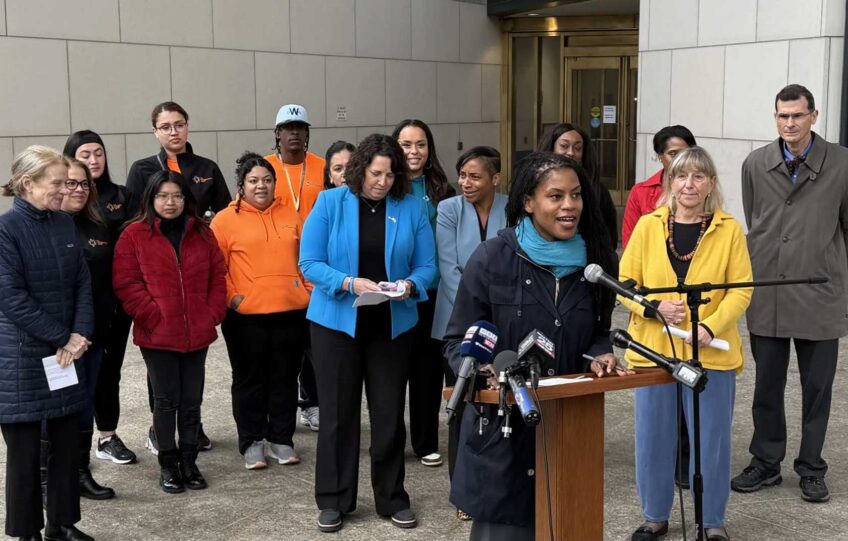A call for more support in BPS budget
Parents, students make case for programs

Boston Public Schools Superintendent Tommy Chang again touted this year’s school budget as the largest-ever during a hearing last week at English High School in Jamaica Plain, citing what he said is a $48 million increase over last year’s budget.
But a procession of teachers, parent activists, students and paraprofessionals who testified during the hearing last Tuesday painted a picture of schools lacking funds for counselors, arts programming, nurses and other basic resources they say students need.
“We all are committed to seeing the Winship school succeed, but it will be difficult without your support,” said Lynelle Pittet, who sits on the parent council of the elementary school in Brighton, which is due to receive a $338,550 cut due to the city’s use of a “student-weighted” funding formula in which school budgets are allocated on a per-pupil basis.
Boston Latin Academy senior Mabel Gondres said that only 59 percent of BPS high school graduates meet the arts requirement in the state’s MassCore guidelines, which are aimed at ensuring students are aligned with college admissions requirements. Gondres, who is in an acting program at the Hyde Square Task Force, advocated for more funding so that students can get class credit for studying arts.
“Out of 1,680 students at Boston Latin Academy, only a third of students receive any arts instruction,” she said.
Parent activists Kristin Johnson and Bob Damon testified that most BPS schools don’t meet state standards for nurse staffing ratios.
“Only 35 percent of BPS schools meet or exceed the state’s recommendations for nurse-to-student ratios,” Johnson said. “It’s very alarming to us that so many of our high schools do not even come close to the state’s minimum recommendations.”

Superintendent Tommy Chang, flanked by School Committee member Michael O’Neil and President Michael Loconto.
The absence of nurses in many schools where they work only part of the day puts pressure on teachers, who are forced to attend to students’ health needs, or parents, who are often forced to pick up sick children in the middle of the work day, Johnson testified.
“When a nurse was present, teachers spent an average of 6.2 minutes per day on student illness or injury,” she said. “When a nurse was not present, teachers spent 26.2 minutes per day on student illness or injury. Having a nurse on-site saves teachers an average of 20 minutes of instruction time per day, benefitting all students.”
Members of the group Educators for Excellence testified at Tuesday’s hearing about the shortage of counselors in schools and its impact on students with trauma. The group’s executive director, Brandy Fluker Oakley, said the American School Counselor Association recommends one counselor for every 250 students. The ratio in Boston’s schools is one for every 1,272 students.
“You have the ability to prioritize social and emotional health by providing the funding to hire more mental health professionals,” Oakley said. “Boston Public Schools should leverage student data, specifically, student mental health data, in order to ensure schools serving the most vulnerable students have adequate mental health staff.”
A question of perspective
The contrast between Chang’s vision of robust school funding and the parents’ and students’ complaints of unmet needs underscores the difficulties the city has faced over the last three years of school budget cycles. In 2016, students staged demonstrations and two walk-outs in protest of deep cuts to schools. Last year 49 schools received cuts to their budget. In this year’s budget, 15 schools are receiving reductions to their budget while an additional 17 have received modest increases that are not keeping pace with increased costs.
Chang last week cited the city’s funding increase, which he said will result in $40 million in new funds going directly to the district’s 126 schools.
But parent activist Bob Damon said the district is counting $33 million that last year paid for salary increases negotiated by the Boston Teachers Union as part of this year’s funding increase.
“It’s like saying the electric bill went up by $30 million and that’s a new investment,” he said. “It’s changing nothing else in the system, but it’s being packaged as an investment in education.”
What gets lost in the budget are funds for basic needs such as copy machines, paper and doors on bathroom stalls, Damon says.
Boston Education Justice Alliance Executive Director Ruby Reyes said the lack of adequate investment in schools affects the quality of education students receive.
“Many schools lack libraries, art and music, and other important elements of a good, 21st century education,” she said in a statement to the media. “Every Boston schools should be a good school. In a world-class city of rapidly growing wealth, there is no excuse for shortchanging our children.”
Reyes’ group is calling for the city to pressure hospitals, universities and other nonprofits to increase their Payments in Lieu of Taxes contributions to help close the funding gap in Boston schools, in addition to seeking more state funding.







